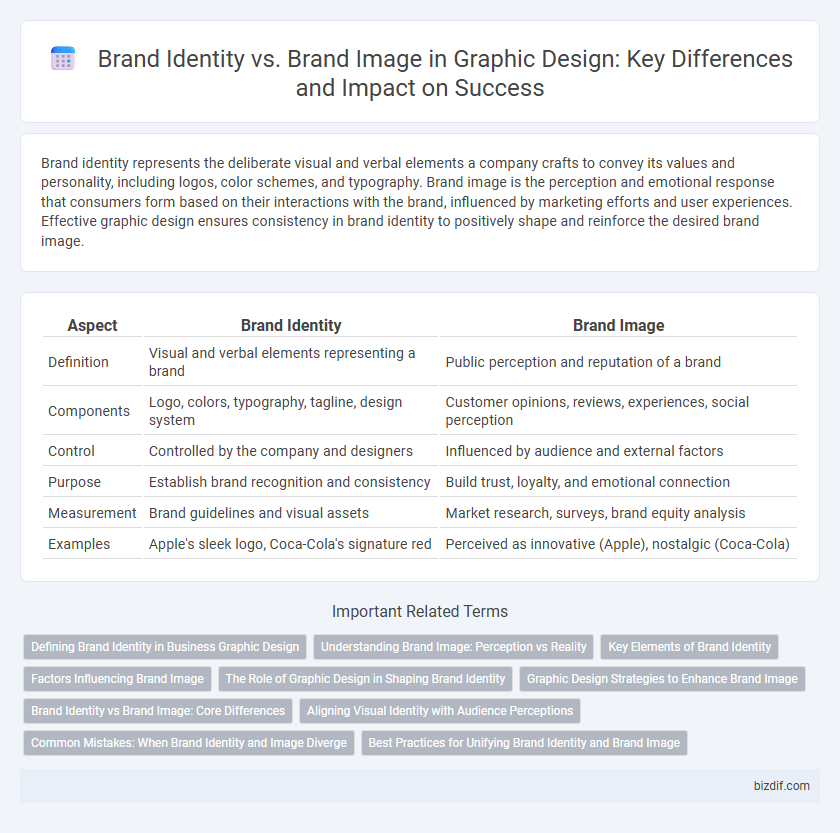Brand identity represents the deliberate visual and verbal elements a company crafts to convey its values and personality, including logos, color schemes, and typography. Brand image is the perception and emotional response that consumers form based on their interactions with the brand, influenced by marketing efforts and user experiences. Effective graphic design ensures consistency in brand identity to positively shape and reinforce the desired brand image.
Table of Comparison
| Aspect | Brand Identity | Brand Image |
|---|---|---|
| Definition | Visual and verbal elements representing a brand | Public perception and reputation of a brand |
| Components | Logo, colors, typography, tagline, design system | Customer opinions, reviews, experiences, social perception |
| Control | Controlled by the company and designers | Influenced by audience and external factors |
| Purpose | Establish brand recognition and consistency | Build trust, loyalty, and emotional connection |
| Measurement | Brand guidelines and visual assets | Market research, surveys, brand equity analysis |
| Examples | Apple's sleek logo, Coca-Cola's signature red | Perceived as innovative (Apple), nostalgic (Coca-Cola) |
Defining Brand Identity in Business Graphic Design
Brand identity in business graphic design encompasses the visual elements and core values that distinguish a company, including logos, color schemes, typography, and design style. It serves as a strategic foundation that communicates the brand's personality and appeals to the target audience, ensuring consistency across all marketing materials. Creating a strong brand identity helps businesses build recognition, trust, and loyalty by visually conveying their mission and unique value proposition.
Understanding Brand Image: Perception vs Reality
Brand image represents the public's perception of a company's identity, shaped by customer experiences, marketing communications, and social interactions. It may differ from the brand identity, which is the deliberate visual and verbal messaging created by designers to convey core values and mission. Understanding the gap between perception (brand image) and reality (brand identity) helps graphic designers tailor strategies to align audience expectations with authentic brand expression.
Key Elements of Brand Identity
Key elements of brand identity include logo design, color palette, typography, and consistent visual style, all crafted to convey the core values and personality of the brand. These components create a cohesive and recognizable appearance that distinguishes the brand in the marketplace. While brand identity is controlled and designed by the company, brand image reflects the public's perception shaped by their experiences and interactions.
Factors Influencing Brand Image
Factors influencing brand image include customer experiences, marketing communications, and visual elements such as logos and color schemes developed by graphic design. Social media presence and word-of-mouth also significantly shape public perception, reinforcing or altering the brand identity created by designers. Consistency in visual identity across all platforms ensures a strong, cohesive brand image that resonates with the target audience.
The Role of Graphic Design in Shaping Brand Identity
Graphic design plays a crucial role in shaping brand identity by visually communicating a brand's core values, mission, and personality through logos, color schemes, typography, and design elements. A strong brand identity crafted through consistent graphic design enables businesses to establish recognition and differentiate themselves in competitive markets. By strategically aligning visual components with brand strategy, graphic design fosters emotional connections and reinforces the intended brand image in the consumer's mind.
Graphic Design Strategies to Enhance Brand Image
Graphic design strategies that enhance brand image focus on consistent visual elements such as logo design, color schemes, typography, and imagery to build a strong brand identity. Utilizing cohesive graphic design across all marketing materials reinforces brand recognition and fosters emotional connections with the target audience. Strategic use of design principles and visual storytelling elevates brand perception, differentiating it from competitors and increasing customer loyalty.
Brand Identity vs Brand Image: Core Differences
Brand identity represents the deliberate visual and conceptual elements a company creates, including logos, color schemes, typography, and messaging, to convey its values and personality. Brand image reflects the public's perception formed through experiences, advertising, and interactions, which may or may not align with the intended identity. Understanding the core differences between brand identity and brand image is crucial for graphic designers to develop cohesive strategies that influence customer perceptions and reinforce brand recognition.
Aligning Visual Identity with Audience Perceptions
Aligning visual identity with audience perceptions ensures that brand identity effectively communicates core values through logos, color schemes, and typography. Brand identity represents the intentional design choices made to convey a brand's personality, while brand image reflects the audience's actual interpretation and emotional response. Consistent, strategic graphic design bridges the gap between these two elements, fostering trust and recognition in target markets.
Common Mistakes: When Brand Identity and Image Diverge
Confusing brand identity with brand image leads to inconsistent messaging that undermines customer trust and loyalty. A common mistake occurs when companies project a carefully crafted brand identity internally but fail to align public perception through marketing and customer experience, causing divergence. Businesses must continually monitor and bridge gaps between their intended identity and external brand image to maintain coherence and strengthen brand equity.
Best Practices for Unifying Brand Identity and Brand Image
Aligning brand identity and brand image requires consistent use of visual elements such as logos, color schemes, and typography across all marketing channels to reinforce recognition and trust. Conducting regular market research and gathering customer feedback help ensure that the intended brand identity accurately reflects public perception and allows adjustments to messaging or design. Empowering employees with brand guidelines encourages uniform communication and behavior, fostering a cohesive brand presence that resonates authentically with the target audience.
Brand identity vs Brand image Infographic

 bizdif.com
bizdif.com